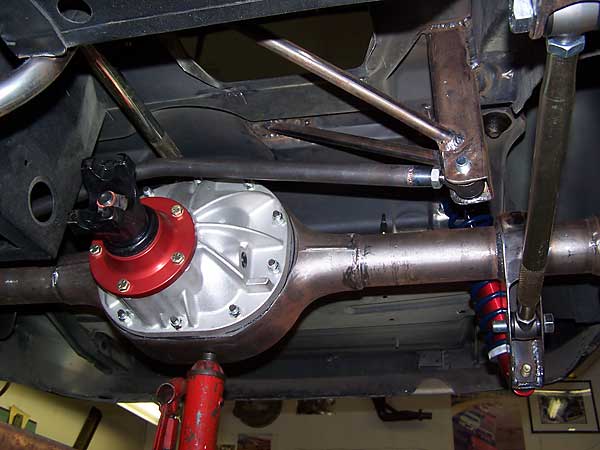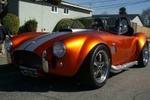watts 3 link
3 posters
Page 1 of 1
 watts 3 link
watts 3 link
Has anyone had any experience with this rear suspension system in late 60s fords.install?performance?qaulity?etc. Thx clyde

waypastcrazy- Posts : 165
Join date : 2009-08-06
Age : 54
Location : collinsville al
 Re: watts 3 link
Re: watts 3 link
something i just read Clyde
Locating devices are used to prevent excessive deflection or movement of the suspension. These are usually used to provide more precise or better location that the stock design provides. There are many types of locating devices such a as traction bars, Watts linkages, radius rods, and Panhard rods. All provide better wheel location than the stock set up.
Locating devices are commonly used at the rear of a car with solid-axle suspension. This type suspension is cheap to build by using longitudinal leaf springs to locate as well as spring the axle.
Lateral location is important when cornering. The side load on the tires is transmitted from the axle to the frame through the leaf springs. The leaf springs bend sideways to carry this load and the rubber bushings in the ends are compliant. This method of location is not very stiff, and the axle can deflect sideways relative to the frame. Thus the rear suspension has a softness which the driver feels as a vague or rubbery feeling in the corner.
The car will respond better if this sponginess is eliminated. Also sideways deflection of the axle requires more clearance for the tires to keep them from rubbing on the wheel wells or springs. If you are using wide tires, this can sometimes be a real problem.
Two popular devices used to locate the rear axle laterally are a Watts linkage and Panhard rod. Both of these do essentially the same thing. They provide a linkage which connects the axle with the frame and gives positive lateral locations. The locating device is much more rigid than springs, and is able to carry almost all the lateral load. The locating device must be free to move in other directions so it does not interfere with the intended motions of the axle.
A Panhard rod is commonly used, as it is simple and cheap. A Panhard rod runs across the car, usually the entire width of the chassis. One end is pivoted on the axle and the other end is pivoted on the frame. It should be horizontal with the car in its normal riding position. A Panhard rod does not provide vertical up an down motion at the end attached to the axle because it arcs about the end pivoted on the frame and there is a slight sideways motion. If the bar is long, if it is horizontal at normal ride height, and if the axle vertical motion is small, then the sideways motion is small and not too important. This is the case for most racing cars.
On a road car with soft suspension and a fairly large amount of wheel travel, a Panhard rod may not be the best answer. The lateral motion allowed by the rod gives a rear-axle steering effect when the wheels rise and fall over bumps. This tends to make the car wander, particularly when going over undulating roads at high speeds. Small bumps will generally not cause any problem because they cause only a small amount of wheel travel.
A lateral locating device which does not have this problem is a Watts linkage. This is more complex and takes up more space than a Panhard rod, so it is not always the best solution. However, the geometry is better and it should be considered if at all possible.
A Watts linkage consists of the two parallel lateral links plus a vertical link connecting them. If the horizontal links are parallel and equal length they will have the same amount of lateral motion as the ends attached to the vertical link. Because each lateral motion is in a different direction, this rotates the vertical link through some angle, but the center of the vertical link is not affected. This center point travels in a true vertical path, and that is where the axle is attached.
A Watts linkage can consist of tubing for the lateral links, using spherical rod ends for pivots. The vertical link is a beam, and should be designed to carry bending loads. The center pivot is usually a rigid bearing on a stud or post so it can rotate but not pivot laterally. If a spherical bearing were used here, the linkage would collapse.
The links must be horizontal or the linkage won't give the proper axle motion. The attachment between the Watts linkage and the axle is a tough problem, and it must be designed strong enough to carry the side loads in cornering.
If the horizontal links on the Watts linkage are too short the linkage may not have enough vertical travel. A Watts linkage goes off perfect geometry at the extremes of its travel. Before building a Watts linkage make sure it has enough vertical travel to allow the full bump-to-droop motion of your suspension. to check this, use a compass and a big sheet of paper to make a scale drawing of the motion. Use the largest scale possible for accuracy. If you run out of travel make the horizontal links longer or shorten your suspension travel with suitable stops. Be sure the suspension wonÕt hit the stops in normal driving.
Some cars come stock with a Panhard rod, these are not very useful for an all-out car. A stock Panhard rod is usually equipped with rubber bushings at the ends, and these ar too flexible to do a lot of good for axle location.
The horizontal links of a Watts linkage built using heavywall tubing and spherical rod ends. The rod must be strong enough to take the cornering loads from the tires plus an occasional bump against a curb. Stress analysis of the rod is rather complex because buckling strength enters into the picture. If in doubt make it stout enough to support the entire weight of the car in compression.
The brackets on frame and axle are problems in building your own Watts linkage or Panhard rod. The height of the pivot point on the rear axle determines the roll center height, and normally you want this as low as possible to minimize weight transfer on the rear tires. Thus the bracket on the frame is usually quite long. Make sure this bracket is strong enough to carry the cornering load from the horizontal link. It is beyond the scope of this book to design brackets, but just keep in mind that the rod should be lined up with the center of the bracket structures so it wonÕt twist. The best bracket designs use double shear, with one mounting plate on each side of the link.
A Watts linkage will improve the handling, perhaps reduce oversteer or provide better high-speed stability.
Locating devices are used to prevent excessive deflection or movement of the suspension. These are usually used to provide more precise or better location that the stock design provides. There are many types of locating devices such a as traction bars, Watts linkages, radius rods, and Panhard rods. All provide better wheel location than the stock set up.
Locating devices are commonly used at the rear of a car with solid-axle suspension. This type suspension is cheap to build by using longitudinal leaf springs to locate as well as spring the axle.
Lateral location is important when cornering. The side load on the tires is transmitted from the axle to the frame through the leaf springs. The leaf springs bend sideways to carry this load and the rubber bushings in the ends are compliant. This method of location is not very stiff, and the axle can deflect sideways relative to the frame. Thus the rear suspension has a softness which the driver feels as a vague or rubbery feeling in the corner.
The car will respond better if this sponginess is eliminated. Also sideways deflection of the axle requires more clearance for the tires to keep them from rubbing on the wheel wells or springs. If you are using wide tires, this can sometimes be a real problem.
Two popular devices used to locate the rear axle laterally are a Watts linkage and Panhard rod. Both of these do essentially the same thing. They provide a linkage which connects the axle with the frame and gives positive lateral locations. The locating device is much more rigid than springs, and is able to carry almost all the lateral load. The locating device must be free to move in other directions so it does not interfere with the intended motions of the axle.
A Panhard rod is commonly used, as it is simple and cheap. A Panhard rod runs across the car, usually the entire width of the chassis. One end is pivoted on the axle and the other end is pivoted on the frame. It should be horizontal with the car in its normal riding position. A Panhard rod does not provide vertical up an down motion at the end attached to the axle because it arcs about the end pivoted on the frame and there is a slight sideways motion. If the bar is long, if it is horizontal at normal ride height, and if the axle vertical motion is small, then the sideways motion is small and not too important. This is the case for most racing cars.
On a road car with soft suspension and a fairly large amount of wheel travel, a Panhard rod may not be the best answer. The lateral motion allowed by the rod gives a rear-axle steering effect when the wheels rise and fall over bumps. This tends to make the car wander, particularly when going over undulating roads at high speeds. Small bumps will generally not cause any problem because they cause only a small amount of wheel travel.
A lateral locating device which does not have this problem is a Watts linkage. This is more complex and takes up more space than a Panhard rod, so it is not always the best solution. However, the geometry is better and it should be considered if at all possible.
A Watts linkage consists of the two parallel lateral links plus a vertical link connecting them. If the horizontal links are parallel and equal length they will have the same amount of lateral motion as the ends attached to the vertical link. Because each lateral motion is in a different direction, this rotates the vertical link through some angle, but the center of the vertical link is not affected. This center point travels in a true vertical path, and that is where the axle is attached.
A Watts linkage can consist of tubing for the lateral links, using spherical rod ends for pivots. The vertical link is a beam, and should be designed to carry bending loads. The center pivot is usually a rigid bearing on a stud or post so it can rotate but not pivot laterally. If a spherical bearing were used here, the linkage would collapse.
The links must be horizontal or the linkage won't give the proper axle motion. The attachment between the Watts linkage and the axle is a tough problem, and it must be designed strong enough to carry the side loads in cornering.
If the horizontal links on the Watts linkage are too short the linkage may not have enough vertical travel. A Watts linkage goes off perfect geometry at the extremes of its travel. Before building a Watts linkage make sure it has enough vertical travel to allow the full bump-to-droop motion of your suspension. to check this, use a compass and a big sheet of paper to make a scale drawing of the motion. Use the largest scale possible for accuracy. If you run out of travel make the horizontal links longer or shorten your suspension travel with suitable stops. Be sure the suspension wonÕt hit the stops in normal driving.
Some cars come stock with a Panhard rod, these are not very useful for an all-out car. A stock Panhard rod is usually equipped with rubber bushings at the ends, and these ar too flexible to do a lot of good for axle location.
The horizontal links of a Watts linkage built using heavywall tubing and spherical rod ends. The rod must be strong enough to take the cornering loads from the tires plus an occasional bump against a curb. Stress analysis of the rod is rather complex because buckling strength enters into the picture. If in doubt make it stout enough to support the entire weight of the car in compression.
The brackets on frame and axle are problems in building your own Watts linkage or Panhard rod. The height of the pivot point on the rear axle determines the roll center height, and normally you want this as low as possible to minimize weight transfer on the rear tires. Thus the bracket on the frame is usually quite long. Make sure this bracket is strong enough to carry the cornering load from the horizontal link. It is beyond the scope of this book to design brackets, but just keep in mind that the rod should be lined up with the center of the bracket structures so it wonÕt twist. The best bracket designs use double shear, with one mounting plate on each side of the link.
A Watts linkage will improve the handling, perhaps reduce oversteer or provide better high-speed stability.
_________________
coming soon x275 build .........
thanks to all my sponsors :
www.OakleyMotorsports.com
www.Induction-Solutions.com
www.bfevansraceparts.com
www.ultimateconverter.com
www.keithfulpmotorsports.com
 Re: watts 3 link
Re: watts 3 link
I think you are have some terminology mixed up. A watts link is used to locate your rearend laterally as explained in Bruno's above post.

A 3 link refers to the bars that attach the rear end to the chassis.

There are two lower links and one upper link like the picture. Three links are hard to package because there is no room for a long upper link. They usually end up protruding right under the rear seat which I am not fond of if you still use it. Another type of 3 link is the Torque Arm that I posted in the first photo.
Here is a link to a 3 link install from Lateral dynamics.
http://www.lateral-dynamics.com/products/install/

A 3 link refers to the bars that attach the rear end to the chassis.

There are two lower links and one upper link like the picture. Three links are hard to package because there is no room for a long upper link. They usually end up protruding right under the rear seat which I am not fond of if you still use it. Another type of 3 link is the Torque Arm that I posted in the first photo.
Here is a link to a 3 link install from Lateral dynamics.
http://www.lateral-dynamics.com/products/install/

jasonf- BBF CONTRIBUTOR

- Posts : 2994
Join date : 2009-07-14
Age : 55
Location : Lafayette, LA
 Similar topics
Similar topics» torque arm 3 link VS 4 link
» Cast iron RHS 460 head?
» 4 link rear set up
» Can you link them up??
» 1995 F150 pro Street project thread
» Cast iron RHS 460 head?
» 4 link rear set up
» Can you link them up??
» 1995 F150 pro Street project thread
Page 1 of 1
Permissions in this forum:
You cannot reply to topics in this forum